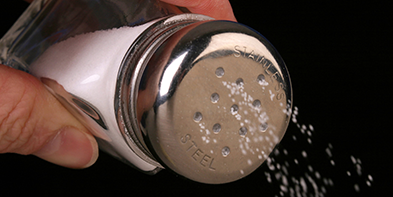entertains, educates & inspires marriages
Find Marriage Answers
health
How to Reduce Your Salt IntakeAlmost all Americans consume too much sodium. Here are simple tips to understand what the various sodium labels mean and how you and your family can reduce your intake.

DepositPhoto
Think twice before you cover your next dish with salt.
“ Decreasing salty foods at mealtimes and in the snack cabinet when children are young gives taste buds a chance to learn to enjoy the natural flavor of foods.”
|
Salt content is listed on food Nutrition Fact labels as sodium. The words "salt" and "sodium" do not mean the same thing, but they are often used interchangeably. In addition to salt, sodium is also found in monosodium glutamate, sodium nitrite, sodium saccharin, baking soda (sodium bicarbonate), and sodium benzoate.
The human body needs a small amount of sodium to maintain a balance of body fluids, keep muscles and nerves running smoothly and help certain organs work properly. Consuming too much salt can raise blood pressure, which can have serious health consequences if not treated. According to the U.S. Food and Drug Administration, about 90% of Americans consume too much sodium.
Americans eat, on average, about 3,300 milligrams (mg) of sodium a day. The USDA recommends consuming no more than one teaspoon, or 2,300 mg of sodium each day. People at risk for high blood pressure should consume no more than 1,500 mg daily.
Decreasing salty foods at mealtimes and in the snack cabinet when children are young gives taste buds a chance to learn to enjoy the natural flavor of foods. Eating more fresh foods and less processed foods will decrease your child’s risk of health problems into adulthood and helps keep parents healthier too.
Here are some tips to help you reduce sodium in your daily meals:
The Top 10 Offenders
If you are like most families, you could probably use a salt makeover. More than 40% of the sodium consumed by Americans comes from the following 10 types of foods:
* Breads and Rolls
* Cold cuts and cured meats (such as deli or packaged ham or turkey)
* Pizza
* Fresh and processed poultry
* Soups
* Sandwiches (such as hot dogs, hamburgers and submarine sandwiches)
* Cheese (natural and processed)
* Mixed pasta dishes (such as lasagna, spaghetti with meat sauce and pasta salad)
* Mixed meat dishes (such as meat loaf with tomato sauce, beef stew and chili)
* Snacks (such as chips, pretzels, popcorn and crackers)
* Eating smaller amounts of these food items will likely reduce your overall sodium consumption.
Read Labels
Nutrition Fact labels provide the most accurate information about whether the food is healthy or not. Use the Percent Daily Value (%DV) to Compare Products—The %DV tells you whether a food contributes a little or a lot to your total daily diet.
5% DV (120 mg) or less of sodium per serving is low
20% DV (480 mg) or more of sodium per serving is high
Product Claims
You can also check the front of the food package to quickly identify foods that may contain less sodium. But beware, labeling can often be misleading. Here is an explanation of some salt/sodium claims:
* Salt/Sodium-Free: Less than 5 mg of sodium per serving
* Very Low Sodium: 35 mg of sodium or less per serving (less than 1.5% Daily Value)
* Low Sodium: 140 mg of sodium or less per serving (Less than 6% Daily Value)
* Reduced Sodium: At least 25% less sodium than in the original product
* Light in Sodium or Lightly Salted: At least 50% less sodium than the regular product
* No-Salt-Added or Unsalted: No salt is added during processing, but not necessarily sodium-free. Check the Nutrition Facts Label to be sure!
5 Simple Tips to Reduce Sodium Intake
Limit the number of fast food meals eaten each week. It is estimated that 75% of dietary sodium comes from eating packaged and restaurant foods. If a hectic schedule has you going through the drive-through more than once each week, choose salads and fruit offerings over French fries, hamburgers and chicken tenders.
Use herbs and spices instead of salt to flavor homemade food. Once taste buds get used to the flavor for homemade soups and side dishes flavored with fresh herbs, the canned and boxed varieties will never taste as good.
Buy unflavored rice and pasta instead of boxed pre-seasoned varieties. Bulk bags of dry pasta and rice is not only healthier for your body, they are healthier for your pocketbook too.
Keep salty snack foods like potato chips, tortilla chips, and salted pretzels to a minimum. Spend more time in the fruit and vegetable aisles of the grocery store and fill your cart with fresh food for snacking first. Baby carrots, pre-cut containers of fruit, and apples with yogurt dip make great snacks.
Choose "low sodium" or "reduced sodium" canned food items. To remove additional sodium, rinse canned foods, such as tuna, vegetables, and beans with water before cooking or eating them.
Cheryl Tallman is the founder of Fresh Baby (www.FreshBaby.com). For more than 10 years, Fresh Baby helped has helped parents foster their children’s healthy eating habits and proactively respond to the childhood obesity epidemic that plagues our nation. Cheryl is the author and designer of the company’s award-winning cookbooks and nutrition education products that support many stages of family life including: pregnancy, breastfeeding, introducing solid foods, and feeding toddlers, preschoolers and school-aged children.
The human body needs a small amount of sodium to maintain a balance of body fluids, keep muscles and nerves running smoothly and help certain organs work properly. Consuming too much salt can raise blood pressure, which can have serious health consequences if not treated. According to the U.S. Food and Drug Administration, about 90% of Americans consume too much sodium.
Americans eat, on average, about 3,300 milligrams (mg) of sodium a day. The USDA recommends consuming no more than one teaspoon, or 2,300 mg of sodium each day. People at risk for high blood pressure should consume no more than 1,500 mg daily.
Decreasing salty foods at mealtimes and in the snack cabinet when children are young gives taste buds a chance to learn to enjoy the natural flavor of foods. Eating more fresh foods and less processed foods will decrease your child’s risk of health problems into adulthood and helps keep parents healthier too.
Here are some tips to help you reduce sodium in your daily meals:
The Top 10 Offenders
If you are like most families, you could probably use a salt makeover. More than 40% of the sodium consumed by Americans comes from the following 10 types of foods:
* Breads and Rolls
* Cold cuts and cured meats (such as deli or packaged ham or turkey)
* Pizza
* Fresh and processed poultry
* Soups
* Sandwiches (such as hot dogs, hamburgers and submarine sandwiches)
* Cheese (natural and processed)
* Mixed pasta dishes (such as lasagna, spaghetti with meat sauce and pasta salad)
* Mixed meat dishes (such as meat loaf with tomato sauce, beef stew and chili)
* Snacks (such as chips, pretzels, popcorn and crackers)
* Eating smaller amounts of these food items will likely reduce your overall sodium consumption.
Read Labels
Nutrition Fact labels provide the most accurate information about whether the food is healthy or not. Use the Percent Daily Value (%DV) to Compare Products—The %DV tells you whether a food contributes a little or a lot to your total daily diet.
5% DV (120 mg) or less of sodium per serving is low
20% DV (480 mg) or more of sodium per serving is high
Product Claims
You can also check the front of the food package to quickly identify foods that may contain less sodium. But beware, labeling can often be misleading. Here is an explanation of some salt/sodium claims:
* Salt/Sodium-Free: Less than 5 mg of sodium per serving
* Very Low Sodium: 35 mg of sodium or less per serving (less than 1.5% Daily Value)
* Low Sodium: 140 mg of sodium or less per serving (Less than 6% Daily Value)
* Reduced Sodium: At least 25% less sodium than in the original product
* Light in Sodium or Lightly Salted: At least 50% less sodium than the regular product
* No-Salt-Added or Unsalted: No salt is added during processing, but not necessarily sodium-free. Check the Nutrition Facts Label to be sure!
5 Simple Tips to Reduce Sodium Intake
Limit the number of fast food meals eaten each week. It is estimated that 75% of dietary sodium comes from eating packaged and restaurant foods. If a hectic schedule has you going through the drive-through more than once each week, choose salads and fruit offerings over French fries, hamburgers and chicken tenders.
Use herbs and spices instead of salt to flavor homemade food. Once taste buds get used to the flavor for homemade soups and side dishes flavored with fresh herbs, the canned and boxed varieties will never taste as good.
Buy unflavored rice and pasta instead of boxed pre-seasoned varieties. Bulk bags of dry pasta and rice is not only healthier for your body, they are healthier for your pocketbook too.
Keep salty snack foods like potato chips, tortilla chips, and salted pretzels to a minimum. Spend more time in the fruit and vegetable aisles of the grocery store and fill your cart with fresh food for snacking first. Baby carrots, pre-cut containers of fruit, and apples with yogurt dip make great snacks.
Choose "low sodium" or "reduced sodium" canned food items. To remove additional sodium, rinse canned foods, such as tuna, vegetables, and beans with water before cooking or eating them.
Cheryl Tallman is the founder of Fresh Baby (www.FreshBaby.com). For more than 10 years, Fresh Baby helped has helped parents foster their children’s healthy eating habits and proactively respond to the childhood obesity epidemic that plagues our nation. Cheryl is the author and designer of the company’s award-winning cookbooks and nutrition education products that support many stages of family life including: pregnancy, breastfeeding, introducing solid foods, and feeding toddlers, preschoolers and school-aged children.
Leave a Comment
|
|
|
|
threshold | life | money | sex | blog | married life social network | partners | directory | wine club | podcasts | newsletters | subscribe | advertise | contact us | press releases | archives | privacy policy
Copyright © 2023 Hitched Media, Inc. All rights reserved. | hitched - entertains, educates & inspires marriages |


